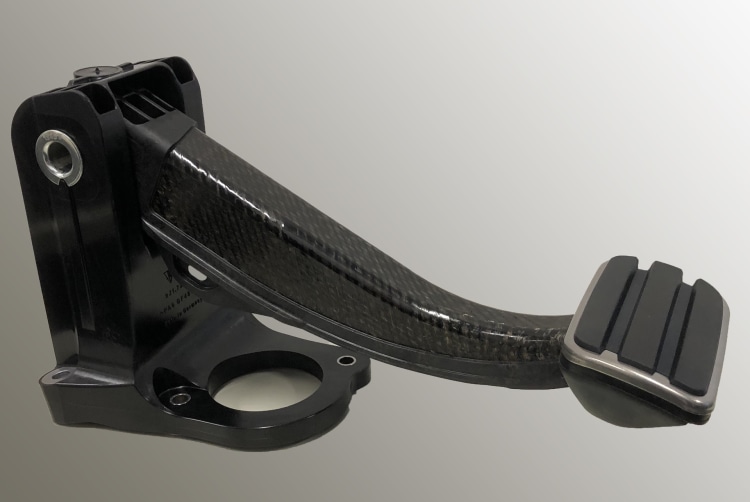
In a battery-electric sports car, every gram of weight counts. That is why the first mass-production vehicle in this segment is using an all-plastic brake pedal. This safety-critical component has been developed by BOGE Elastmetall GmbH, a global provider of vibration technology and plastics applications for the automotive industry, in close cooperation with the Lanxess High Performance Materials (HPM) business unit. It owes its high mechanical strength and very low weight to a thermoplastic composite design. Its structure comprises an insert made from Tepex dynalite, a continuous-fiber-reinforced thermoplastic composite from Lanxess , and several tapes.
“The composite structure makes the brake pedal 50 percent lighter than a comparable steel design. The structural component meets the demanding load requirements thanks to the tailor-made fiber-layer construction of the Tepex insert and additional local tape reinforcement. Extensive automation allows the geometrically complex safety-critical component to be manufactured efficiently and in a way that is suitable for large-scale production,” explains Dr. Klaus Vonberg, an expert in lightweight design at HPM's Tepex Automotive Group.
Precise combination of fiber layers arranged in various orientations
The fully consolidated semi-finished products Tepex dynalite have a thermoplastic matrix that is typically reinforced with layers of continuous glass-fiber fabric. The brake pedal for the battery-electric sports car uses a composite structure with a polyamide 6 matrix, which contains unidirectional fiber layers inside and fabric layers with fibers arranged at 45° angles on the two covering layers. The inner layers are what give the component its excellent tensile and bending strength.Tapes are thin plastic strips with unidirectionally oriented, high-strength continuous fiber systems embedded in the thermoplastic matrix. Multiple tapes with glass-fiber rovings are used in the brake pedal to reinforce the bottomside of the component. Since the tapes and the Tepex insert consist of mutually compatible plastic matrices, the tapes can simply be welded onto the Tepex insert using a laser. This results in tailor-made laminates with fiber layers that follow the load paths precisely and are adapted to the exact load-specific component requirements. The covering layers of the insert with their 45° fiber layers, combined with the tapes on top, thereby ensure the high torsional strength of the pedal.

Four brake pedal versions in series production
“This tailor-made fiber-layer structure and the combination of organic sheets and tapes have made it possible to reduce brake pedal weight even further while simultaneously achieving the exceptionally high level of mechanical characteristics that such a safety-critical component needs to provide,” says Dr. Daniel Häffelin from the Innovation Center at BOGE Elastmetall. There are currently four different brake pedal designs in mass production based on an all-plastic version. For all component versions, the load paths are also optimized to suit the various torsion directions.Automated processing of tapes and Tepex
The brake pedals are manufactured in an automated process using hybrid molding in short cycle times suitable for large-scale production. The method integrates draping of the Tepex insert and the tapes in the subsequent injection molding process. The first stage of production involves aligning the tapes precisely using optical measuring systems and then positioning them on the Tepex insert so that they can be welded to it. This assembly is thermoformed and then back-molded with polyamide 66 by an injection molding process.High-strength structural components for electric vehicles
New opportunities are opening up in the field of electric vehicles for thermoplastic composite structures with tailored fiber orientation. According to Vonberg, “Examples of applications for Tepex inserts include front-end systems and bumper beams, brackets for electrical and electronic modules, trunks and spare wheel wells, battery housings and covers, structural components in the vehicle's 'greenhouse' section and structural trims in the underbody area to protect the battery.”The low carbon footprint relative to metal-based structures is another point in favor of the composite design with Tepex and tapes. Thermoplastic composites are not only much lighter than such alternatives, but the hybrid molding method used means that they also enable functions such as guides, holders and fasteners to be integrated in a way that saves weight, energy and costs. With components of this type, there is no need for time-consuming further processing such as deburring or post-process tapping, as this is typical for metal parts.



